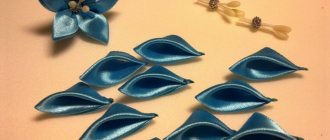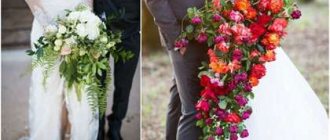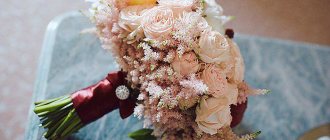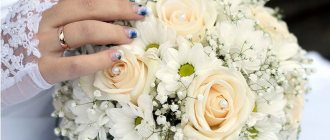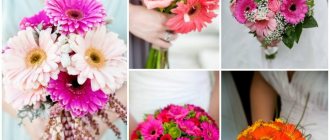A wedding is an ancient rite that is full of different symbolism. Almost every action of the bride in Rus' had a special meaning, which gave rise to many interesting signs before the wedding and during the celebration itself. The outfit and all accessories for the holiday were selected with special care, including the bride’s bouquet, for which there are many signs even today, which the website www.svadbagolik.ru will tell you about.
What should the bride's bouquet be like?
In this regard, there are several basic rules about the flowers from which the bouquet is made. They should be:
- alive, because artificial ones are a symbol of grief and sadness;
- light shades, which symbolizes a bright future and tender feelings of the young;
- have good symbolism, since not all flowers carry positive energy, for example, as you know, yellow tulips are harbingers of separation.
Perhaps the only obligatory observance is that the bouquet must be composed of fresh flowers. As for the shades and varieties of flowers, these days the beauty of a bouquet is more valued than its symbolism. However, if you want to follow the signs, then here are a few options for which flowers are best to make a bridal bouquet:
- white or red roses - the former symbolize tender affection, and the latter passionate love (but you should not choose tea roses - they promise separation);
- orchids personify the promise to always be together and fidelity until the end of life and promise a speedy replenishment of the family;
- lilies - with their help, a man says that he promises to take care of and protect his beloved from adversity;
- chrysanthemums - the sincerity of the groom’s feelings and his complete trust in his chosen one;
- daisies speak of the pure and sublime love of a young man;
- irises are an assurance that the couple will overcome all difficulties together and will not separate.
When choosing flowers for a bouquet, you should take into account that lilies and orchids have a strong smell, so if the bride is sensitive to strong aroma, it is better to avoid them.
Where to put the bride's bouquet after the wedding
A bouquet of fresh flowers can be safely stored at home for both the bride and her bridesmaids. It will serve as a talisman, protecting against evil spirits. In the USA, England and other Western countries, the newlywed keeps a bouquet at home only for the first year after the wedding, after which she burns it.
To preserve flowers , they should be dried. You can do this in two ways:
Volume drying
Here are the instructions for action:
- Remove all decorative elements from the bundle.
- Clear the composition of wilted buds and leaves.
- Attach the flowers to a wire about 1 meter long.
- Tie the bundle to the wall in a dry and dark room.
- If you see mold on the bouquet, wipe it with a damp sponge.
- The flowers will take approximately 3-7 days to dry.
- The finished composition can be placed in a vase and stored in the newlyweds’ room.
You can watch how to dry roses in this video:
How to dry flowers using varnish
You can also preserve a bouquet in the following way:
- Wipe leaves and stems.
- Separate the wilted particles from the bouquet.
- Spray the flowers with medium hold hairspray.
- Place the branches in a cardboard box and dry it for a week or two, remembering to open it from time to time.
It should be borne in mind that the method of drying flowers using varnish is not very practical, since the petals coated with it tend to break.
Signs about a wedding bouquet should in no case dictate what you do with it, this is your personal choice!
Big Village - Site about Samara, which is interesting to live in
Choosing a bouquet seems like an easy task until you encounter it in practice: the flowers must fit into the overall decoration of the holiday, not wither in the first half hour, look good in the photos, and in the end - survive the throw without crumbling in the air. The editorial bride of the “Big Village” Polina Kuznetsova went to the “Botanika” flower shop and asked expert florists to tell us what the ideal bouquet should be like: what to look for when choosing, where you can save money and what the groom should do with the boutonniere.
When to go to the florist
You need to go to the flower shop no later than three weeks before the wedding
Ideally, the appearance of the bouquet should be taken care of a month in advance: it is during this period that it becomes clear which flowers will be included in the composition. There is no point in ordering six months in advance - closer to the date, it may happen that suppliers do not have a suitable shade of the desired type. This is a common situation that not every florist warns about. To avoid disappointment, consider replacement options in advance: flowers can be chosen so that the difference is minimal.
Busy brides often coordinate the look of their bouquet online. Botanika advises not only to evaluate photos of roses, but also to take the time to look at them in person: a photo cannot always convey the real shade.
What to consider when choosing
A disheveled, free-form bouquet will visually shed a few pounds on the bride
The bouquet should complement the bride's image - it's good if you come to the florist with a photo of the dress and an idea of wedding makeup. It is worth considering the girl’s color type: for example, delicate shades will be lost in the hands of a fiery brunette. The type of figure matters: flowing bouquets will look ideal only for tall and slender brides, and small round compositions will unfavorably emphasize the volume. Do you want to look slimmer in your wedding photos? Choose a modern “disheveled” bouquet - it will allow you to visually lose a couple of kilos.
The bouquet can refer to the overall design, but should not copy it. The color scheme can be any - but it is worth considering that the shades look more advantageous than uncompromising notes - it is better to replace blood scarlet with deep wine or light coral.
What's trending now
Properly selected wildflowers look more elegant than peonies
In the photo: autumn bouquet with berries
At the beginning of the 2000s, complex accessories were in fashion: bouquets in the form of fans and handbags or glamelias (large hand-picked flowers - for example, giant roses). Nowadays preference is increasingly given to loose, slightly careless structures.
Peonies and peony-shaped roses are always at the peak of popularity - now they are competing with wildflowers in combination with herbs or cereals. In winter compositions, nobilis, cones, lucospermum, small pomegranates are added to the flowers, and apples in the fall. Berries, such as blueberries, are also on trend - but there is a risk of crushing them and leaving a stain on the dress. If there is no doubt about accuracy, you should take it!
Is a boutonniere necessary?
Guys are afraid that peonies and eustomas will soften their image too much - nothing like that!
The accessory has a symbolic purpose (it shows the connection between the bride and groom) and a practical one - flowers add freshness to the appearance. Guys are often afraid that peonies and eustomas will soften the image too much - nothing like that. A huge rose in a breast pocket can only be seen in Soviet films - now grooms' suits are decorated with miniature compositions with brutal elements - for example, hard fruits. Convenience is also okay: boutonnieres are attached with magnets or clip-on fasteners, and their shape can be either a strict rectangle or an elongated line. A good accessory will survive the hugs of hundreds of aunties from the village and cost a reasonable 300 rubles.
How much does it cost and how to save?
In the photo on the left: a bride's bouquet with carnations. In the photo on the right: one of the boutonniere options
You can replace expensive hydrangeas with cloves - the appearance will be practically no different
The composition does not have to be expensive at all - the cost of a bride’s bouquet starts from 3,500 rubles. It includes flowers, decoration and work of the florist - and also a guarantee that the bouquet will last until the end of the evening.
Many hit plants have inexpensive analogues. Carnations are undeservedly forgotten at weddings: they are inexpensive, durable, and you can drown in a sea of shades. They can replace eustomas without losing the quality of the composition.
If your budget is extremely limited, florists advise not to look for cheap flowers, but to set your priorities wisely. The bouquet will be with you in all the photos, and it is better to invest in it than, for example, in mini-compositions on the tables of guests, which will get lost in the banquet hall, but will cost a lot.
How to make flowers last longer on your wedding day
Disheveled bouquets look fresh only for a few hours
The more tightly the bouquet is assembled, the longer the plants will last at their post - this applies even to delicate roses and hydrangeas. In heat and cold, flowers are capricious. If you can’t escape the weather, you should think about a substitute bouquet that will replace your flower brother indoors.
At the banquet, agree on a flower vase in advance. If you need to invigorate the petals in express mode, sprinkle them with water. The rules are elementary, but if you follow them, the bouquet will look decent until the evening - get ready that you will even feel a little sorry for throwing it to your girlfriends.
VKontakte, Instagram
Flower shop "Botanika": st. Chapaevskaya, 87, tel. 990-54-05; 6th clearing, 129, tel. 240-14-05, from 9.00 to 20.00 seven days a week
Subscribe to our Instagram - only important news and beautiful photos of Samara
Who should buy the bouquet?
Signs about the bride's bouquet clearly state that it should be bought by a man, usually the groom. With the help of a bouquet, he entrusts his heart to his beloved and promises a happy life with him. But if for some reason he cannot buy it, then this is allowed to be done by the father or a close friend of the groom, who is usually a witness.
Modern wedding fashion requires that the bouquet be combined with the bride’s outfit, so girls often choose it themselves. But, if you want to maintain traditions, then all your participation should be limited to wishes for the colors from which it will be composed. But the choice should remain with the groom.
Throwing a bouquet: how did the sign of an early marriage appear?
Initially, there was no talk of any bridal bouquet. Girls getting married decorated their hair with flowers, and that was all. There are several versions of how the tradition and signs appeared related to the fact that the bride began to take a bouquet with her to the wedding and throw it at the end of the holiday:
- European. In Europe it all started with a superstition about a wedding dress. It was believed that if you managed to pick up a piece of the dress for your young self, it would bring good luck to the family or promise a meeting with your future spouse. Such superstitions led to the fact that at best, half of a beautiful dress was left at the end of the evening. Therefore, over time, brides began to decorate their outfits with small arrangements of flowers, which anyone could rightfully take for themselves without ruining the wedding dress. Well, then it transformed into an action when the bride throws a bouquet to unmarried girls.
- Russian. With the help of a bouquet, the young man tested the feelings of the girl he liked. He collected a large beautiful bouquet of wildflowers and presented it to her as a gift. If a girl accepted such a gift, it means that the feelings were mutual, and matchmakers could be sent to her. Unlike Europe, in Rus' it was considered a good omen to simply touch the bride, and not disfigure the dress. Nevertheless, you must admit, it’s not very pleasant when hundreds of people (weddings at that time were always celebrated on a grand scale) touch you all evening. Therefore, over time, a tradition associated with the bouquet also appeared. But the Russian bride did not leave him. The girl who would take the bouquet was determined in a round dance.
- American. This is the most touching story. One of the brides, knowing that her best friend also wanted to get married, simply presented her bouquet with wishes of happiness in love. And many brides wanted to do the same. But since the bridesmaid might not be alone, we had to organize a throwing of the bride’s bouquet to determine who would take it.
Wedding bouquet: traditions and superstitions
There are many customs, signs and even superstitions associated with the wedding ceremony.
Whether to strictly follow the rules or do things their own way is something each couple decides for themselves. But many people are still interested in learning about wedding signs. The wedding bouquet itself is traditional. It so happened that a girl walking down the aisle always holds flowers in her hands. But not everyone knows that the bride should not see her bouquet before the wedding day. According to tradition, he is chosen by the groom, or, in extreme cases, by the witness.
Modern brides strive to ensure that their main celebration is impeccable in everything, and therefore they often order a bouquet themselves. But this custom has deep roots. To choose a bouquet that his future wife will like, a young man must know her taste, habits and preferences.
But there is a small discrepancy - according to the signs, the groom should never see his bride’s wedding dress ahead of time, but it must match the dress. So, the problem is not an easy one.
In order to pass the test with honor, you need to show ingenuity and attentiveness, learn to listen and understand each other - this will be very useful in family life.
The groom hands the bouquet to the bride after he has gone through all the standard and non-standard “procedures” of the ransom. After this, the bride will release the flowers from her hands only during the ceremony at the registry office. While the newlyweds are exchanging rings, the bouquet passes into the hands of a witness, who symbolically guards it.
Many traditions and signs are associated with the appearance of the bouquet itself.
Of course, fashion and personal preferences play a significant role here, and few people today think about the symbolism of color and the language of flowers. But traditions still exist. The classic bridal bouquet consists of many short white roses. White (the most commonly used color of wedding dresses and veils) is a symbol of purity, roses are a sign of love and tenderness.
A bouquet of lilies indicates chastity, moral purity, and sincerity.
By the way, according to one of the traditions, the bride’s bouquet must be composed of flowers of the same type. And they must certainly be in full bloom: it is believed that closed flowers mean a closed road. The number of flowers in a bouquet is also symbolic. Everyone knows that it should be odd. The luckiest numbers are three, seven and eleven.
And the most interesting and long-awaited tradition associated with a wedding bouquet is its throwing by the bride. And the lady who is still free from the bonds of marriage and who catches him will become a happy bride in a very short time.
This custom came to us from Europe and quickly became everyone’s favorite and incredibly popular. No wedding is complete without this.
An important detail. According to one of the existing signs, the bride must dry what she received from the groom.
It is believed that preserving this heirloom helps to be happy in marriage, and as dried flowers are preserved, so will love be preserved.
What to prefer or how to reconcile two customs, each decides in its own way. Some have found a way out: the bride throws her bridesmaids not a real bouquet, but a copy of it.
Such a bouquet is sometimes made exactly like the bride’s bouquet, sometimes it is smaller, but repeats the “main” one in style.
Whatever option is chosen, throwing a bouquet remains a very fun and positive tradition. It’s so nice to share your joy!
Source: https://bulavochki.ru/?p=6440
Is it worth blindly following traditions?
At a time when flower shops did not yet exist, the girl herself prepared a wedding bouquet for herself.
She selected special flowers and herbs there, and each of the plants carried a meaning with its presence, personifying love, prosperity, tenderness, or protecting the newlywed from the evil eye and envious people during the ceremony and feast.
It was from there that the tradition began and continues to this day, according to which the bride was not supposed to let go of the bouquet during the wedding, and in case of emergency it could be given to the mother or groom, but in no case to the girlfriend or any of the guests. When the feast begins, flowers are placed on the newlyweds’ table and then taken to the newlyweds’ room. On the morning after the first married night, the bouquet is dried and stored away from prying eyes, most often in a linen bag, specially sewn for this purpose, among bedding.
But what to do with the custom of throwing a bouquet to unmarried friends? If the bride is suspicious and believes in omens, then for this purpose it is better to order a second one, exactly the same, and use it for this purpose.
The times of the bride making her own flower arrangement are long gone, and today it is customary that the groom buys and gives a bouquet to his betrothed before they go to the registry office, this is a symbol that the girl has accepted his proposal and is ready to become an official wife.
However, it is not necessary to blindly follow this tradition, since such issues are decided individually.
Besides, buying and choosing (ordering) are two different things. According to signs, the bride's bouquet should be made only from living plants; it is believed that artificial flowers are not suitable for a wedding and “hint” at falsity in married life. Believing this or not is a matter for everyone, but if the wedding is scheduled for the cold season, and it is important for the bride to have a bouquet of, for example, poppies in her hands, then the delicate flowers will not tolerate the cold and may simply crumble.
In this case, it is advisable to use a copy of them; it is better than being completely left without a bouquet in the midst of a celebration.
The bride's bouquet is both an object of tradition and a work of art.
The second publication dedicated to flower week:) We are talking about the bride’s bouquet.
A bride's bouquet is the widest field for imagination for any florist, no matter what flowers he uses to make a bouquet :) A combination of color, size, shape, additions.
A wedding bouquet must be selected taking into account a lot of nuances. The height, figure, character of the bride, style and color of her dress are the determining factors in choosing a wedding bouquet.
Where did this bouquet custom come from? The word bouquet comes from French. BOUQUET (Explanatory Dictionary of V. I. Dahl) m. French. bunch, sheaf, bunch of flowers, bunch; - a sheaf or bunch of rockets or other funny lights launched at once; - *smell, spirit, aroma and spicy taste of grape wines. Bouquet, bouquet, relative. to the bouquet. Bouquet maker, -chitsa, gardener selling bouquets; flower girl
That is, it is a group of flowers collected together. The first bouquets were so small that they could be pinned to a dress or inserted into the buttonhole of a jacket. In other words, the bouquets were similar in size to brooches. Now the bride's bouquet can be very different in size.
In ancient times, women wore garlands around their necks made of various herbs and plants, often having a distinct scent. This was needed to scare away wild animals and evil spirits. For example, among the ancient Celts, such a garland could consist of thistles, heather and ivy. For the ancient Greeks, on the contrary, the garland meant fertility, hope and new life.
Later, the garland smoothly flowed into a wreath, which was a symbol of eternity and immortality. It was put on the bride's head. In Rus' there was just such a custom. Nowadays, wreaths as decoration for the bride’s hair have become very popular again. Let's return to the bouquets.
The first bridal bouquet most likely appeared in the hands of Queen Victoria of Great Britain and Empress Victoria of India in 1840, when she got married. Then in her hands there were not at all traditional plants for such a celebration. These were marigolds interspersed with dill. For some reason (from the point of view of a modern person), the guests and the bride and groom had to eat this dill. This is surprising precisely because dill was considered a plant that enhances sexual desire :). These were such interesting traditions then.
In the Middle Ages, the language of flowers also appeared. It is believed that Turkey became its homeland in the mid-17th century. Then the language of flowers became actively widespread in Europe. During the time of Catherine the Great, there was even a whole registry of color meanings. For example, blue flowers, according to the document, were a symbol of fidelity. Thanks to this language, an indispensable set of flowers appeared in the bride’s bouquet, which was designed to carry information about love, wealth, fertility, joy and happiness.
The bouquet, which is now called a classic wedding bouquet, is round in shape and not particularly intricate, it appeared at the beginning of the 19th century. This bouquet consisted mainly of roses of different shades.
Today, not a single wedding is conceivable without flowers :). It is the bouquet that emphasizes the grace and uniqueness of the bride. For example, for a tall girl, a flowing or cascading bouquet is perfect, if the bride has a tight-fitting dress, if the dress is lush, then a small round bouquet is more suitable. The bouquet should match the character of the bride and the nature of the event. The wedding ceremony is either a wedding ceremony, a solemn ceremony, or a modest registration of marriage.
Bouquets using the assembly technique are on their own stems, collected in a porta bouquet, i.e. with cut stems and taped bouquets. A bouquet on its stems can be placed in water, but the advantage of an assembled bouquet on a porta bouquet holder is that it can last longer, and using the taping technique, the bouquets turn out to be fantastic, very unusual.
The shape of the bouquets comes in the form of a waterfall, an umbrella, a handbag, or a fan.
Where did the custom of throwing the bride's bouquet come from?
This tradition originates in England in the 14th century. At the end of the holiday, unmarried girls approached the bride and tore off a piece of her dress for good luck. The dress of a bride who became a wife was considered a talisman of a married woman. Dresses became more expensive every year, and not every bride wanted to leave her own wedding in rags. And then the brides began to throw whatever they could get their hands on at their guests in order to keep them away from their outfit. Therefore, flowers turned out to be a good choice, since they symbolized fertility and good luck, and after the celebration they were thrown away. By the way, the garter was the same item of good luck :) only for men :).
Today, brides end their wedding by throwing a bouquet to their unmarried friends standing behind them. It is believed that the one who catches him will soon marry. A small “flower” dictionary that may help you choose flowers for a bouquet not only because of their beauty, but also because of their meanings.
Pale pink rose - happiness, lisianthus (eustoma) or winter rose - calm, muscari (mouse hyacinth) - trust, loyalty, romance and fullness of energy, eucalyptus - memory, ranunculus (buttercup) - nobility, narcissus (white) - on the tongue flowers attention, annunciation, meekness, humility.
Hortensia - “Remember Me”; modesty, sincerity, hope. Many peoples believe that hydrangea has the ability to ward off illness and misfortune.
Alstroemeria - in the language of flowers means “sweet”, “lovely”.
Chrysanthemum (regular ) - “You are a wonderful friend,” joy, openness, fun and relaxation. Chrysanthemum comes from the Greek words chrysos (gold) and anthos (flower). The Chusan daisy became the “pompom chrysanthemum”, this name originated in France because. they looked like pom-poms in sailors' hats. Chrysanthemums were cultivated in Chinese gardens over 2,500 years ago and transported to England in 1795. The chrysanthemum has been a symbol of Eastern flattery for centuries. In China, chrysanthemums are associated with autumn and the harvest. The chrysanthemum was considered one of the four Chinese "noble symbols" (along with bamboo, plum and orchid) and was the official symbol of the Old Chinese Army. The Chinese believe that a chrysanthemum, given to a lover and rubbed on the lips after wine, guarantees immortal love. Chrysanthemums were featured on the Imperial Coat of Arms of Japan. The Japanese believe that a chrysanthemum petal placed at the bottom of a glass of wine promotes a long and healthy life.
Peony - in the language of flowers, a happy wedding, a cheerful life, compassion.
Gerbera - mystery, smile. Feel free to choose these flowers if you want to share your great mood with someone or give a compliment.
Tulip is a symbol of pure love, great happiness; glory, pride; harmony. The flower is the emblem of Holland. Tulip (red) - declaration of love, congratulations. "Trust me", "I wish you happiness"
Orchid - love, tenderness, sophistication, intimacy. It is customary to give orchids only to loved ones. Chinese symbol of having many children or You are a beauty!
Poppy (in general) - imagination, daydreaming.
Chamomile - youth, innocence, romance.
Freesia - trust. Lily - Lily (white) - purity, purity, majesty, nobility. “It’s divine to be next to you!!!” Flower of the Virgin Mary.
Sweet pea - thanks for the great time, let's start a new life :).
Sakura - purity, loyalty, friendship, love. A traditional symbol of female youth and beauty.
Plumeria - psychological perfection. It is believed that the five petals of this flower represent the five components - sincerity, faith, devotion, aspiration and surrender.
Lilac - beauty, love, the first excitement of love.
Muscari (mouse hyacinth) - trust, loyalty, romance and fullness of energy; orchid - in the language of flowers, love, sophistication, beauty; lisianthus or winter rose - calmness,
Orchid - love, tenderness, sophistication, intimacy. It is customary to give orchids only to loved ones. Chinese symbol of having many children or You are a beauty! Peach rose - bringing lovers closer together, Pink rose - perfect happiness or Please believe me! love, grace, tenderness. Rose (yellow) - happiness, joy. "You are my sun". A flower that expresses the most positive emotions. According to the language of flowers, yellow roses have nothing to do with betrayal and jealousy (although this interpretation of their symbolic meaning is very common). Rose (cream ) - elegance, harmony, perfection, constancy. "I remember. Always!”, “You and I are the perfect couple”, “You are beyond praise!” Blue rose - romance.
I wish everyone a happy family life and invite you to take a closer look at the wedding sets and decorations made by my hands - the “Morning of the Bride” collection and take advantage of the 20% discount.
Throwing the bride's bouquet
In connection with this ritual, a girl getting married always has two questions: what bouquet does the bride throw and how does she do it? We have already found out that the signs associated with a wedding bouquet do not allow it to be given to anyone. Fortunately, a way out of this situation has long been found - an understudy.
A duplicate bouquet is a flower arrangement that usually resembles the main bouquet in appearance or simply repeats its colors. It is allowed that the understudy consists of textile flowers. So, it will be lighter in weight, so the likelihood of injuring someone with it while throwing it is minimal. However, when choosing which bouquet to throw at a wedding, modern brides are increasingly giving preference to arrangements made of paper, soft toys and other unusual materials. They look original, do not symbolize anything bad and can be kept for a lifetime.
How to throw bridal bouquets? This can be done not only in the traditional way, but also in a more original way: a round dance according to the Old Russian rite, a ritual using ribbons, etc. Or you can not throw it at all, but simply give the bouquet to your friend with best wishes, making this process as safe as possible. If you want to make everyone happy, then you don’t have to throw a bouquet, but give each girl a flower from it, you can even attach small cards with wishes to them.
Wedding fashion: Traditions of a wedding bouquet
Share
Share
Tweet
Cool
Wedding floristry plays a significant role in the celebration. The bride's bouquet is one of the main attributes at a wedding, which is why wedding traditions associated specifically with flowers have appeared in many countries. The bouquet is given symbolic meaning; each type of flower, as well as color combinations in it, is carefully selected.
There are many old traditions associated with wedding flowers, which are still relevant in various countries.
Even in Ancient Greece, brides took a branch of ivy to their wedding; this plant in those days symbolized the beauty and purity of the bride. Currently, decorative ivy is also used in wedding bouquets.
A little later, the orange flower became a traditional wedding symbol for Greek brides. Orange trees were specially planted for newlyweds in advance. Fragile white flowers symbolized the innocence and purity of the bride. There is another tradition associated with these flowers: often the wedding dress was decorated with the finest embroidery, in which orange flowers were woven.
Another unusual tradition that is still relevant today appeared in sunny Italy - decorating a wedding car with flowers. It was believed that such a car would take the newlyweds to a happy future.
As for the bouquet itself, the Italians have a special name for the wedding day “Fiori d'Arancio” (orange flowers), most often Italian brides chose an orange bouquet, which subsequently served as the origin of this catchphrase. A modern bride can highlight her Italian wedding with a bouquet of sunflowers.
In Thailand, wedding flowers are a symbol of good luck. During the ceremony, the mothers of the bride and groom hang flower garlands, also called Puang Malai, around the newlyweds' necks. It is believed that these flowers will bring happiness and harmony to family life.
At a traditional Indian wedding, literally everything is decorated with flowers; they symbolize the couple's new life and happiness.
There is also a long tradition associated with wedding flowers in India. At the end of the wedding ceremony, the groom's brother showers the couple with flower petals; this ritual was supposed to protect the newlyweds from evil spirits.
The history of the English wedding bouquet is rich. In the Victorian era, great importance was paid to the symbolism of flowers; roses were then the flowers of love and devotion, and in our time a bouquet of these beautiful flowers is considered traditional.
During the Tudor dynasty, the bride's bouquet consisted of daisies soaked in rose water. Such flowers were considered excellent aphrodisiacs, so the bride ate them after the ceremony.
England has a tradition of throwing the bride's bouquet at a wedding. This ritual brings good luck to the bride.
Source: https://modagid.ru/articles/780
Variety (types) of duplicate bouquets
When it is decided that a “spare” bouquet is still needed, all that remains is to figure out what it will be like. Despite the relatively recent appearance of this attribute at modern weddings, its own rules and traditions have already formed.
What are stand-in bouquets made from?
- An exact copy of the original is the simplest solution, which is not accompanied by new torments of choice. When ordering a bridal bouquet for a wedding in a florist shop, you must immediately specify that it be made in duplicate. This is suitable for a winter wedding or a two-day celebration. It won't be cheap, but no one will notice the difference.
- A mini bridal bouquet is the optimal solution when the main composition is too large or complex to throw. However, they will not be much different. This can be a miniature copy in the same color scheme and from similar colors.
- An artificial bouquet is a small gift for a happy bridesmaid. The girl who catches it can keep it as a souvenir or even use it later at her wedding, as a kind of lucky talisman for her unmarried friends. This is a good option, given the lightness and unique similarity of most artificial flowers to real ones.
- Hand bouquets - for creative and original natures. Why make a duplicate bouquet identical to the original if you can show your imagination and skills as a needlewoman? The materials used are ribbons, tulle, various types of fabrics, sequins, beads, candies - anything that can be used to form flowers or an abstract bouquet.
Sometimes the bride's second bouquet is not a whim, but a necessity. He will protect himself from unnecessary worries and awkward moments. May this day be perfect.
Bouquet for a wedding
A holiday without flowers is like the sky without stars. This is approximately what people in all inhabited corners of the Earth have believed since ancient times.
There is no need to convince anyone that a wedding has always and everywhere been one of the most beloved celebrations. It is not surprising that from time immemorial gifts of flora have accompanied marriage.
But a wedding bouquet was and remains not just a beautiful gift, it is an important component of special matrimonial rituals.
Why do you need a bouquet for a wedding: ancient legends
A couple of thousand years ago, the bride’s bouquet looked completely different than it does now, and not only decorated the newlywed, but performed an extremely useful function from the point of view of our ancestors - it protected the young from the evil eye and ensured the future well-being of their family union.
The wedding bouquet was a wreath of wildflowers and forest plants, endowed, according to the ancestors, with sacred symbols and magical powers. Such wedding amulets crowned the heads of both spouses.
According to Slavic customs, the bride wove a wreath for the groom and, after the ransom, put it on the betrothed. Now the flower crown has been replaced by a wedding boutonniere , and the responsibility for its availability has fallen on the shoulders of the future head of the family.
For the newlywed, the wreath was carefully composed by married women who knew a lot about secret meanings. Weaved and embedded in it:
- flowers, stems, fruits, twigs of viburnum, periwinkle, ivy, laurel, garlic, boxwood, wheat, rue, onion, myrtle, rosemary, basil, red pepper, lovage;
- coins, rings, raisins, sugar.
Putting on the wreath was preceded by the ritual of unbraiding the braid and covering the face with a veil or veil.
Most often, after the celebration, the wreath (read wedding bouquet ) was kept for luck under the images or sewn into the bride’s pillow and used in the household with full dedication:
- put the child in the cradle to prevent childhood diseases;
- given in powder form to babies for fear;
- fumigated the house for illnesses and insomnia of children;
- drove away hail clouds;
- cows were transferred through it after dating bulls to increase fertility;
- they milked cows through it if their milk yield suddenly dropped;
- They were given as an amulet to sons going to war.
Less often, the wedding bouquet (that is, a wreath) was given to the mother, an unmarried friend, or left in the church. In some regions, before leaving the wedding feast, the newlyweds relayed their crowns to the couple who were about to get married. Is this why the Western tradition of throwing the bride’s bouquet has taken root so quickly at today’s city weddings?
Today, instead of maids, florists collect both a bouquet and a boutonniere for a wedding , but they do it no less inspired than their sophisticated predecessors and timid brides once did.
Why do you need a bouquet for a wedding: a fresh look
A poetically succinct and brief answer to this question was formulated half a century ago by Vladimir Vysotsky: “What is a wedding without flowers? Booze, that’s all!”
What do the signs promise for the one who caught the bride’s bouquet?
Great happiness and good luck in love. But, according to the legend, this will only happen if the girl who caught the bride’s bouquet keeps it. By the way, when she gets married, she can use the same bouquet as a backup. This is considered a good tradition, as it will make him even luckier and bring the new owner a lot of joy in life.
The Svadbaholik.ru portal reminds that the bride herself should save her bouquet. Previously, it was kept for a lifetime, but today it is believed that the main thing is that the bouquet should be in the house for the first year of the couple’s life together.

